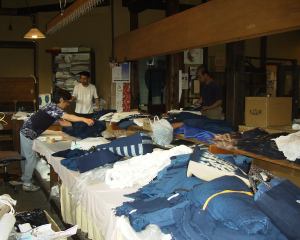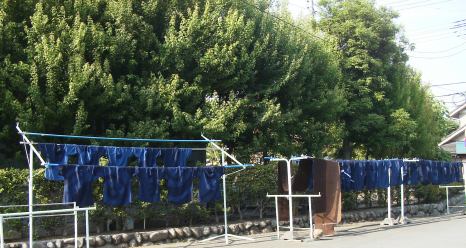|
|
|
|
|
 |
|
|
![]()

|
Welcome to 'Kosoen' This is the entrance of the Japanese Indigo dyeing Studio 'Kosoen' in Ome City, in western Tokyo. Surrounded by hills and blessed with plenty of good water, this area has produced textiles since ancient times, and it is said that textile production has flourished in this area since 13th century. As cotton became a common material Ai (indigo) dyeing of clothing for daily use became very popular because it added durability and other benefits to the clothes - such as protecting people from insect bites. The need for Aizome increased and the business continued to prosper. It is not only cotton that was dyed here. Until quite recently many farmers in this region kept silkworms. Silk was also a suitable material for Aizome. Many mulberry trees are still to be seen in this area because their leaves were harvested for silkworms' food. In the 19th century this industry was strongly affected by cheap indigo dye imported from India. The invention of synthetic indigo in Germany then had an even stronger impact, and the labor-intensive dyeing methods using Japanese Ai declined dramatically. Kosoen is one of a few Studios that has survived to the present day by stubbornly maintaining the traditional way of Aizome - Japanese Indigo dyeing. |
![]()
![]()
---![]() ---
---
|
Entrance If you walk along that stone path and open the entrance door you will see a showroom where their products are exhibited ... but let's take a round-about way and look at the backyard first. |
......................................................................
|
Backyard On the right side of this picture (next photo on the left), there is a nice Japanese garden but the thing that attracts most visitors' eyes is the row of these huge vats. Murata-san, the owner of this studio, explains that those are one of the essential tools for indigo dyeing, but it is almost impossible to obtain new ones nowadays. They are large enough for an adult to sit in and these solid looking treasures add gravity to this building. There are more vats on the other side of the studio (next photo on the right) and it seems they have enough vats to continue the business for some hundreds of years. |

![]()
![]()
|
Inside Let's go into the studio. Stepping inside the building you will see a huge space with no partitions! Only a few very solid posts are holding the entire ceiling! Since sunlight from the windows doesn't reach the center part of the room they have the ceiling lights turned on all day long. This retro lamp shade suits the atmosphere very nicely! |

..................................................
|
Dyeing As your eyes get used to the dim light you will start looking around the room. Just in front of you are the buried vats full of indigo liquid for dyeing. Many ladies are soaking and rubbing clothes in the liquid. When the cloth is thin like gossamer one dip might be enough, but for thick cloth they have to repeat this process quite a number of times. |

|
This is the other side of the room. There are always mounds of products here. The staff at Kosoen is busy inspecting and ironing the final products for shipping. Mr. Murata (on the right) is constantly checking orders and their stocks. |

![]()
![]()
|
Drying When dyeing is done washing process comes. They repeatedly wash and rinse out the indigo pigment which is not fast in the fibers. Since they use 100 percent natural indigo extract from Ai(Polygonum tinctorium) the color is very fast. The colour of Aizomed cloth will change gradually as it wears, thus adding subtle shadings to the fabric. |

![]()
![]()


![]()